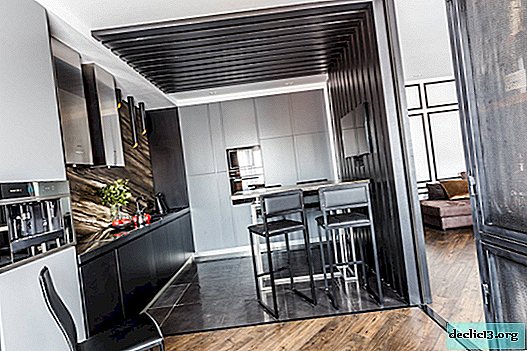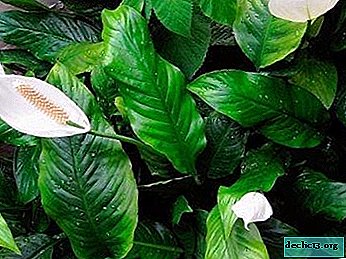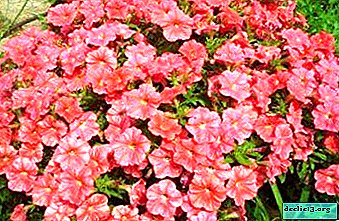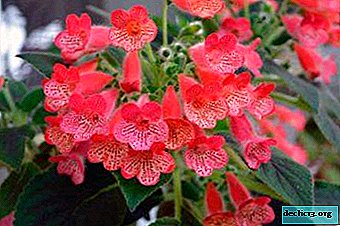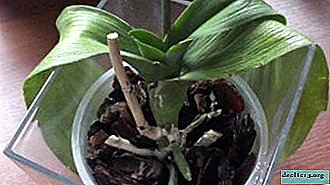“Bottle tree” - jatropha: photo, description of species, recommendations for home care
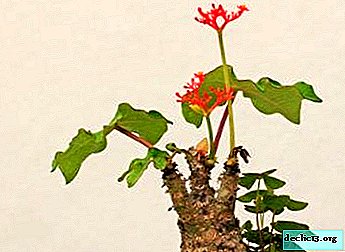
Beautiful and unpretentious succulent jatropha is a beautiful exotic plant. It decorates living quarters and gives umbrellas of small flowers of unsurpassed beauty. Another name for the plant is a bottle or coral tree, given a thickened stalk similar in shape to a bottle.
From this article you can get information about popular plant species, see their photos, learn about reproduction, flowering, the dangers to which this succulent is susceptible (diseases and pests).
What it is?
Jatropha belongs to the family of euphorbiaceae. The name comes from "Jartys" and "tropha", which literally means medicinal food. The trunk of the plant is like a bottle; if damaged, it releases poisonous milky juice. Depending on the variety, the jatropha is a shrub, tree or perennial herb. Habitat tropical Africa and America.
In winter, all leaves fall off the stem, resuming from spring with small flowers collected in an umbrella. Broad-bladed leaves on long stalks appear after color, reaching a length of 20 cm. The plant is bred in botanical gardens or greenhouses, and for a home flowerpot this species is expensive, so this is not a frequent resident in apartments.
Popular views, their description and photos
The variety of jatropha varieties unites over 170 species, of which only two are used for decorative purposes in indoor conditions. Milky juice is secreted only from the stem, although all parts of the plant are toxic. Like bonsai, these plants in any room focus on themselves.
Spicata (jatropha spicata)
The plant is a perennial semi-dry shrub with semi-woody stemsthat persist for several years. Branches reach 0.5-2 m in height, growing from a rather puffy, almost tuberous base. The plant is sometimes harvested from the wild for local medicinal use. It is found in the natural environment in Africa: Somalia, Kenya, Tanzania, Angola, Zimbabwe, the northern part of the continent. The plant propagates by seeds.

Multi feed
It is found in the form of an evergreen tree with a loose, spreading crown or shrub, it can grow up to 6 m in height and with decorative content up to 2-3 m. It is planted with the aim of obtaining oil and preparing potions from it.
It originates from the Old World, where it was used as a hedge. Red inflorescence is in great demand among florists for beautiful corsages. All parts of the plant are poisonous. In the wild, spreads in the Caribbean: Trinidad in Cuba, in South America - Mexico.
The plant loves full sunshine or partial shade on well-drained soils.. Moderately tolerates drought. Jatropha multifrida produces flowers throughout the year, especially in hot weather.

Kurkas (jatropha curcas)
Another unique species is rare - jatropha kurkas, flower growers are called Barbados walnuts. A plant with a powerful trunk up to 4 m in height and densely dotted with pointed oval leaves of light green color, the size of which can be 6 cm or even 40 cm in diameter in one plant. Unlike the previous species, kurkas blooms with bright yellow female umbrellas and male single flowers.
Reference! Old specimens are quite large, like the famous village tree from Chigodore in Mozambique with a height of more than 6 m.A versatile tree with a very wide range of usesIt is cultivated in the tropics as a food, medicinal plant, hedge, biofuel and oil extracted from seeds. Pollinated by insects. Leaves lose during a drought. All parts of the plant are extremely toxic.

Gouty
The most popular representative is the gouty jutropha, or gout.. In appearance, this is a 70-centimeter bottle-shaped stem, belted at the top into a whorl by 20-centimeter cuttings, which are almost centrally attached to the leaf plates. The shape of the leaves is round and reaches 20 cm in diameter similar in shape to fig leaves.
The color of greens changes with age: from a bright shiny dark green color to a matte and lighter shade. The primary dark tone of the leaves returns when it reaches its maximum size. Light grayish coating covered the lower part of the leaves and the stalk on the underside.
A powerful brush of flowers grows from the center of growth of leaves. Coral red flowers become when the peduncles grow to their maximum height. As a rule, the flower is odorless, similar to an asterisk with a diameter of 1 cm. Male representatives bloom only 24 hours, and female representatives 2-4 weeks, periodically alternating with new ones. Due to the release of fruiting, the flowering period can reach 6 months.

Care Features
The plant requires minimal care from the grower. In the cold season, you need to take care of the rest period: store at a temperature not lower than 16 ° C. Young succulents need a transplant every spring, and adults can be stored in one pot for up to three years. Transplantation is performed before the onset of the growing season.
Peat land with perlite or a cactus earth mixture will be suitable for the soil. Fertilize the jatropha should be the same fertilizers that are suitable for cacti, strictly during the growing season.
Watering should be moderate in the summer and spring, limitedly in the autumn, completely stop hydration until the end of winter.
Whole
Very elegant, with sprawling branches, a tree that does not stop blooming with coral, 1-1.5 cm in diameter, flowers. The plant is shade tolerant and drought tolerant.. Outwardly, it is a small tree or a sprawling bush with thin branches, which in nature does not exceed 3 m.
The leaves are large, grassy-green, the flowers are small - 1-1.5 cm in diameter, bright red-coral or pink, but appear constantly in large numbers throughout the year. It can be grown indoors - the plant will be much smaller in size.

Berlandieri
The plant is a dwarf tree with a lush crown. Mostly cultivated for caudex. Dumps foliage according to the season and blooms with small colorful flowers. In the summertime, numerous oblong spikes with red flowers on short pedicels grow on a round caudex or a swollen stem. Pea-shaped green berries are tied with them. The highest representatives reach 15 cm in height. The temperature should not be lower than 10 ° С.

Home Care
Lighting and location
The plant develops well in sunny and bright places, requires shading. Direct sunlight can cause burns on the leaves. It is best to place decorative jatrophs in pots on the western and eastern windowsills. If the succulent has been in low light for a long time, then it should be accustomed to light gradually.
Temperature
The optimal temperature regime for the jatropha is considered to be + 18- + 22 ° C in the summer and + 14- + 16 ° C in the winter days. At room temperature, plant care is greatly facilitated.
Humidity
The plant is resistant to low moisture in the air. There is no need to perform additional spraying. But wet cleaning of sheets from dust jatropha will be useful.
Watering
Water the plant with settled soft water in moderation. Watering is done by drying the top layer of the substrate. The plant may die due to rotting of the root system with excessive watering. To drink the jatropha in winter should be limited, stop altogether after dropping the leaves of the plant.
The soil
The best soil for the plant is a drainage mixture of turf, peat, sand, humus leaves and soil in a ratio of 1: 1: 1: 2.
Fertilizer and fertilizing
Fertilizers should be applied monthly to the soil in summer and spring, in winter it should be discarded. Ideal top dressing are cactus fertilizers. They can be bought at flower shops.
Transfer
Jatrophs are transplanted once for several years in the spring.. You should choose wide and shallow pots. It is imperative to provide the plant with a good drainage system so that there is no stagnation of water.
Breeding
Propagation of the jatropha is carried out by seeds or by growing from a lignified shank.
Seeds
 Seeds are purchased in a flower shop or grown independently in the presence of an adult plant. For the second option, you need a brush and simple manipulations of transferring from yellow male stamens of pollen to female flowers. Pollination should be performed in the early days of the appearance of male flowers. Ripened seeds are thrown over considerable distances (up to 1 m), so it is worth tying boxes of gauze.
Seeds are purchased in a flower shop or grown independently in the presence of an adult plant. For the second option, you need a brush and simple manipulations of transferring from yellow male stamens of pollen to female flowers. Pollination should be performed in the early days of the appearance of male flowers. Ripened seeds are thrown over considerable distances (up to 1 m), so it is worth tying boxes of gauze.
The landing process consists of the following steps:
- A box or a pot for seedlings is selected.
- Preparing the soil: a mixture in a ratio of 1: 1: 1: 2 turf, peat, sand, humus leaves and earth.
- Seeds are sown in shallow holes, closed with a glass jar.
- The germination period takes 1-2 weeks.
- As soon as the sprouts hatch, they are transplanted into a separate wide low pot.
- Plants mature in a couple of months.
- In the course of growth, the trunk thickens, at first the leaves become rounder over time. The first flowers and lobed leaves appear next year.
Cuttings
For propagation in this way, slightly lignified or semi-lignified cuttings are selected. The breeding process is reduced to the following steps:
- The collected cuttings are dried.
- Processing is carried out with heteroauxin or another drug to stimulate growth.
- A low wide pot is selected.
- A mixture of soil is being prepared from earth, sand and humus in a ratio of 1: 1: 1.
- Ready for planting cuttings are placed in the soil and lightly watered.
- Provide temperature conditions of 30-32 ° C.
- A month later, the stalk takes root and takes root.
Bloom
The plant begins to bloom in March. Usually these are small flowers of various shapes, single or gathered in umbrellas. The appearance of peduncles occurs before the development of foliage after a winter discharge. If the plant is kept in favorable conditions and good care is taken, it can produce flowers throughout the year. Flowering frequency - annually.
Attention! If the plant did not give flowers or stopped flowering, the level of lighting and the location of the jatropha should be checked.These are photophilous herbaceous plants that bloom while observing the temperature regime and lighting. If the jatropha ceased to bloom in poor lighting conditions, it is necessary to change its location in the house. She feels best of all on the western and eastern windowsills.
If the plant is cold, it can not only stop flowering, but wither. Watering should be moderate and the desired temperature should be provided for several days. When the jatropha is kept in cloudy conditions, it should be accustomed to light gradually to avoid sunburn.
Diseases and Pests
Like all indoor plants, the jatropha can suffer from various diseases or pests, the most common are:
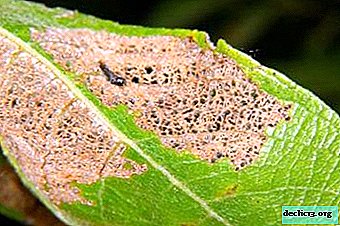 The leaves of the plant bleach and fade when used for watering cold water, for this it is worth slightly warming it.
The leaves of the plant bleach and fade when used for watering cold water, for this it is worth slightly warming it.- With overfeeding, the jatropha can slow growth, it should moisten the soil before fertilizing and do it sparingly.
- The defeat of flowers by thrips leads to their falling and deformation. For treatment, warm water is used to rinse the plants and treated with a solution of insecticides.
- Attacks of spider mites observed yellowing and falling of the leaves of the jatropha. To eliminate them, spraying the plant with warm water in the initial stages and insecticidal treatment for extensive lesions will help.
- The roots of the jatropha rot due to excessive watering, which can destroy the plant. You can save by reducing the amount of water used for irrigation.
Conclusion
Jatropha is considered a picky and easy-to-care plant.. The cultivation of this succulent is even for beginner growers. Wild jatrophs can reach impressive sizes - up to 6 meters in height. In the tropics, plants are used for landscaping the streets. In medicine - to create alternative fuels from seed oil, etc. Hedges from various types of jatropha look very organic and beautiful, but the plant survives only in a climate with a temperature of at least 10 ° C.

 The leaves of the plant bleach and fade when used for watering cold water, for this it is worth slightly warming it.
The leaves of the plant bleach and fade when used for watering cold water, for this it is worth slightly warming it.





